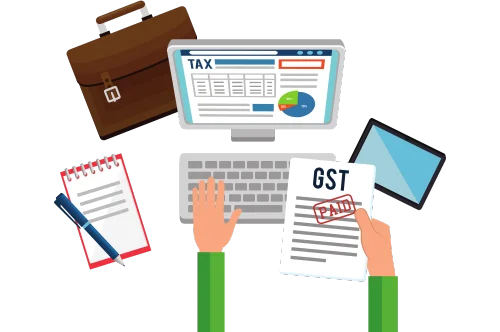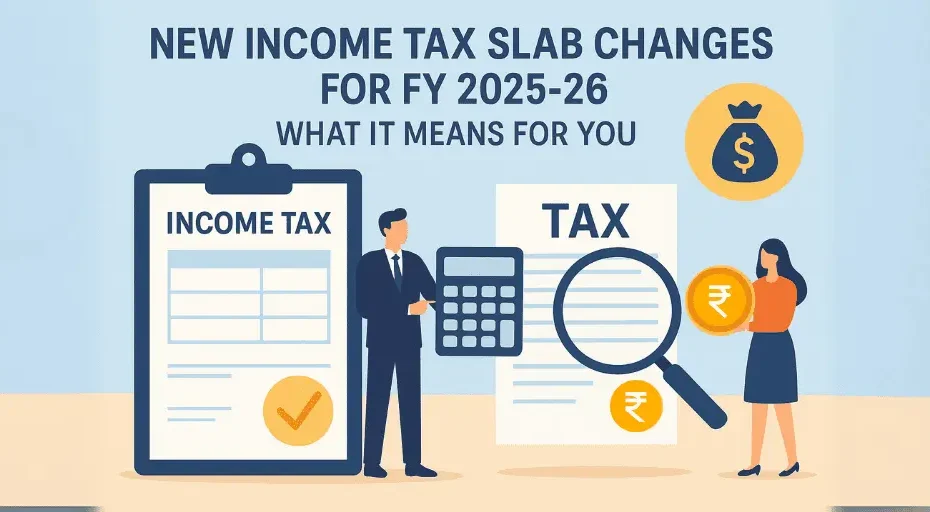New Income Tax Slab Changes for FY 2025-26: What It Means for You
The Union Budget often brings excitement and curiosity among taxpayers, and this year is no different. The announcement of the income tax slabs 2025 26 has once again become a hot topic of discussion for salaried individuals, professionals, and business owners. Understanding these new changes is crucial, as it directly impacts your take-home salary, investments, and financial planning. In this blog, we will break down the key highlights of the new tax regime, compare it with the old system, and explain what these changes mean for you.
What Are Income Tax Slabs?
Before diving into the updates for FY 2025-26, let’s quickly revisit what tax slabs mean. Income tax in India is levied based on a progressive system. This means higher income attracts higher rates of taxation. These ranges of income and their corresponding tax rates are known as income tax slabs. Every year, the government reviews and, if necessary, revises these slabs to adjust to inflation and changing economic needs.
With the new income tax slabs 2025 26, the government aims to simplify taxation, reduce the burden on middle-class taxpayers, and promote compliance.
Key Changes in Income Tax Slabs 2025 26
The finance minister has proposed several changes to the tax regime. Here are the main highlights:
Revised Income Brackets
The new income tax slabs 2025 26 have adjusted income brackets to ensure more disposable income in the hands of taxpayers.Lower Tax Rates for Middle-Income Groups
Tax rates for individuals earning between ₹7.5 lakh and ₹15 lakh annually have been reduced. This directly benefits the salaried class.Standard Deduction Benefits
Salaried individuals can still enjoy a standard deduction, making the new income tax slabs 2025 26 more attractive compared to earlier years.Focus on New Tax Regime
The government is encouraging taxpayers to adopt the simplified new regime by making it more beneficial than the old system. The majority of benefits now lie within the new structure.
New vs. Old Regime: Which One Should You Choose?
One of the biggest dilemmas for taxpayers is choosing between the old and new regime. The income tax slabs 2025 26 make the new regime appear more appealing, but is it right for you?
Old Regime: Best suited for those who heavily invest in tax-saving instruments like ELSS, PPF, NPS, and housing loan deductions.
New Regime: Ideal for those who prefer straightforward taxation without depending much on exemptions or deductions.
With the income tax slabs 2025 26, the government has made it clear that the new regime is the future, although the old system still exists as an option.
Who Benefits the Most from Income Tax Slabs 2025 26?
The changes are designed to provide relief across different categories of taxpayers:
Salaried Employees: More take-home salary due to lower rates.
Middle-Income Families: Reduced burden for households with annual income between ₹10–15 lakh.
Senior Citizens: Simplified taxation makes financial planning easier.
Business Professionals: Less dependency on complicated tax-saving strategies.
Thus, the income tax slabs 2025 26 offer wider benefits compared to previous years.
Practical Examples of Savings
Let’s look at a couple of examples to understand how the new income tax slabs 2025 26 affect real taxpayers:
Example 1: A salaried individual earning ₹8 lakh annually. Under the new regime, the tax payable is lower compared to the old system, resulting in higher take-home pay.
Example 2: A professional earning ₹12 lakh annually with minimal deductions. The new income tax slabs 2025 26 significantly reduce their tax liability.
These examples highlight why many may shift towards the new regime.
Impact on Investments and Tax Planning
The new income tax slabs 2025 26 also impact investment strategies:
Taxpayers may no longer need to invest heavily just to save taxes.
Focus will shift from tax-saving schemes to wealth-building investments like mutual funds, equities, or real estate.
Individuals who earlier relied on deductions might have to reconsider their financial planning approach.
This shift simplifies taxation but requires a smarter investment mindset.
Common Misconceptions
Many people misunderstand the changes in income tax slabs 2025 26. Here are some clarifications:
Myth 1: The old regime is no longer available.
Truth: It is still available, but the government is promoting the new regime.Myth 2: Higher income groups do not benefit.
Truth: While middle-income taxpayers benefit the most, even higher earners save due to adjusted brackets.Myth 3: All deductions are removed.
Truth: Some deductions like standard deduction still apply.
Steps You Should Take Now
If you’re wondering how to prepare for the income tax slabs 2025 26, here’s a quick checklist:
Compare your tax liability under both regimes.
Consult with a financial advisor to restructure your investments.
Plan your salary and bonus structure accordingly.
Stay updated on official notifications for finer details.
Final Thoughts
The income tax slabs 2025 26 represent a significant shift toward simplified taxation. For most middle-class taxpayers, the changes bring good news in the form of reduced tax burdens and higher disposable income. However, every individual’s situation is different. Choosing between the old and new regime depends on your income structure, investments, and financial goals.
By carefully analyzing your options, you can ensure maximum benefits under the new income tax slabs 2025 26. This year’s changes could be the start of a more streamlined tax system in India, paving the way for growth and financial stability.
Our GST Services

All E-commerce Tax services
E-commerce tax services help online sellers navigate GST registration, compliance, return filing, TCS management, tax planning, and audits, ensuring efficient tax management and legal compliance.

GST Filing
GST filing is the process of submitting tax returns to the government, detailing sales, purchases, and taxes paid or collected, ensuring compliance with GST laws.

GST Registration
GST registration is the process where businesses obtain a GSTIN from the government, allowing them to collect taxes, claim input tax credits, and comply with GST laws.





